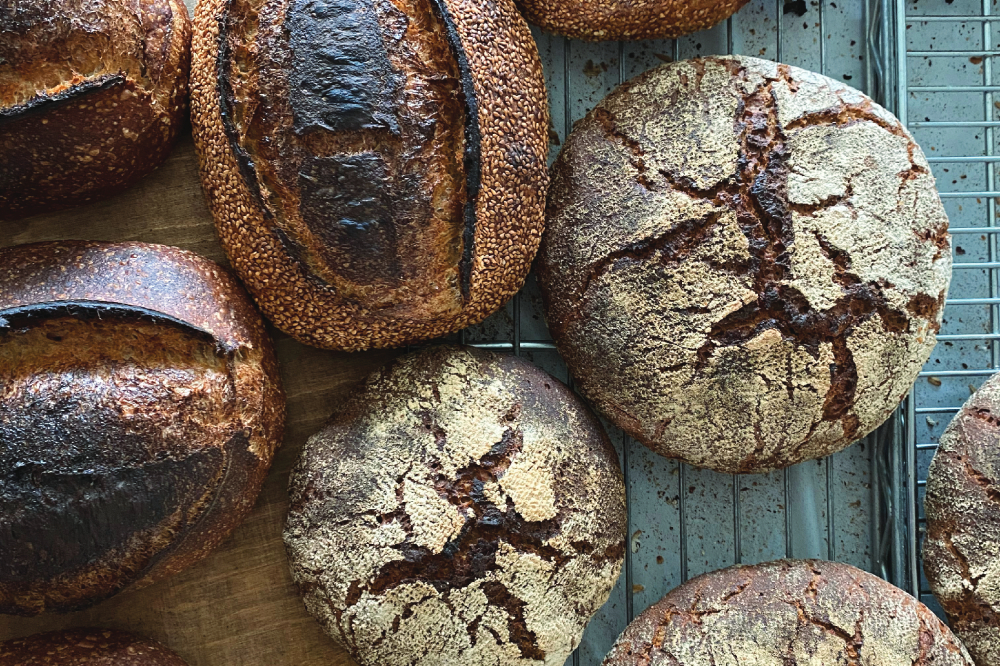Eat
 Bread. Photo by Rick Cook.
Bread. Photo by Rick Cook.
Manifesting a Bakery
February 1, 2023 @ 10:00am
Rick Cook and his wife have been in the restaurant industry for decades: he as a cook and his wife Tyes as a front-of-house manager. Before the pandemic, while Rick was working first at Etto and then at 2Amys, he began experimenting with baking at home and applying some of the techniques he saw at work. (He used some of the leftover flour from work, too.)
He sold a couple dozen loaves at a weekly wine tasting at Weygandt Wines in Cleveland Park. Back then, he was making two loaves at a time in his home oven, long-fermenting the sourdough in the fridge and using lidded cast iron pots for the bake. Between the rise and the baking, he needed a full day to produce a bread loaf.
Then the pandemic hit, and Rick found himself with a lot more time as restaurants shuttered their doors.
So, the Cooks started a monthly bread subscription service — a grain to gate, if you will (sorry, I love alliteration). Business was brisk and ballooned thanks to a fortuitous article in DCist (and a painting-worthy loaf picture).
“Overnight, I had 50 emails from people waiting to get on the delivery list,” he says. “We would post the menu on Instagram in the morning, and it would sell out in minutes.”
With this good problem on his hands, Rick upgraded his kitchen oven and got a mill to grind the flour. Much like the ever-multiplying yeast, the Cooks moved from making 12 to 200 loaves. They also started selling cookies and other baked goods.
The Cooks’ lifelong dream of opening their own restaurant manifested itself in the burgeoning bakery operation.
“We just had a kid, and I really started thinking seriously about building something for our family [that] I could pass down in a sustainable way,” Rick says. “A bunch of people from the restaurant industry moved into real estate and switched careers, but I realized the baker’s schedule of 4 a.m. – 5 p.m. is actually not a bad way to raise a family. My wife and I were so used to working 12 hours, and we saw this as something different. I have been cooking for 20 years and wanted to stay with the craft. This was perfect.”
About a year ago, the Cooks signed a lease to found Manifest Bread, their very own bakery dedicated to quality handmade products, in Riverdale, Maryland.
“[Even though] we signed the lease a year ago, we are opening in September. This gives you an idea of how much preparation goes into equipping and designing the space.”
Riverdale is close to Cottage City, home to the Cooks’ OG cottage food home bakery. They also ran a wildly successful Kickstarter campaign which overshot its goal in just 20 days. With the funds, they bought a stone mill, oven and mixer.
Milling the flour right before it is used is critical for the flavor profile (as any bread connoisseur will tell you), but it also makes for a beautiful bread biome of nutrients, oils and pre- and probiotics. Rick also sources local spelt, wheat and rye from Maryland and Pennsylvania.
“It is going to be a bit strange being in a commercial space,” Rick laughs. “Right now, our dining room doubles as the baking space. We have about 1,000 pounds of grain under my son’s bed.”
Rick describes himself as “the bread boy,” while Tyes wields “the binder and the bullhorn.” And much like baking, the Cooks’ dream of a space to call their own manifested itself organically.
“There is this huge underground community of home bakers across the country that feels very much like a family. We share tips and puzzle over techniques — the yeast is wild and has a life of its own. The rise seems to come out of nowhere and has its own kind of energy and pull.”
Manifest Bread: 6208 Rhode Island Ave. Riverdale Park, MD; manifestbread.com // @manifest_bread
Give your carb knowledge a boost with these essential terms.
Alveoli: The holes created in the crumb of the bread. Many artisan breads boast an uneven structure with translucent strands of gluten.
Crumb: The interior of a loaf of bread. Often described as either open crumb (lots of irregular holes) or closed crumb (fine-textured).
First rise: The first fermentation after the dough is mixed but before the loaf is shaped. Also known as bulk fermentation.
Gluten: The proteins that allow dough to stretch out and maintain its shape. When combined with water, it gives structure to baked goods.
Maillard reaction: The reaction that occurs when a mix of protein, starch and water is heated above 250 degrees. It contributes to the browning of the bread crust and caramelized flavor.
Proofing: The final rise of dough after it is shaped. Also known as the second rise.
Sourdough: A culture of wild yeast and lactic acid bacteria that ferments cereal grains. Also known as sourdough starter or levain.
Gluten-free? Go with sourdough.
Bread that does not rely on commercial yeast strains for a quick rise is easier to digest — especially for those who have trouble with gluten, a protein that breaks down almost fully before the bread is baked.
When you mill your own flour — as we would have in days past — the result is a more rustic bread with a significantly richer array of nutrients, much higher fiber and a far lower GI. The fiber of whole grains contains many prebiotic fibers that fuel the good bacteria in the gut, promoting their growth.







